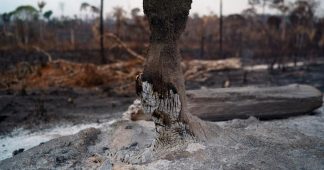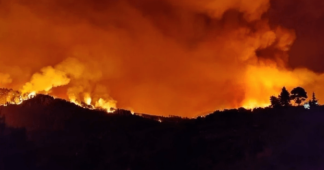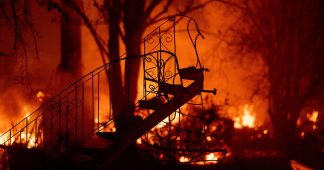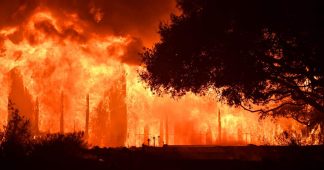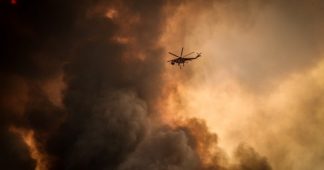By Dawn Stover
August 12, 2021
photo: Dixie Fire on August 4, 2021. Credit: CAL FIRE
I woke last Thursday to the news that Greenville, California, had been incinerated by the Dixie Fire, the second-largest fire in California history at nearly 500,000 acres. My friend Jane, who lives two miles from Greenville and has endured multiple evacuations since the fire began in mid-July, wondered how anyone returns to a community with no post office, no hardware or drug store, no library, and no gas station closer than a 50-mile round trip. The destruction looks a bit like Hiroshima after the firestorm of 76 years ago, but with a Dollar General store standing in for the iconic Genbaku Dome.
In Washington state, I spent that afternoon listening with one ear to a thunderstorm and the other to my scanner radio. Only a few drops of rain fell on my house and the surrounding forest and fields, parched by drought and record-breaking heat. There were so many lightning-sparked fires happening at once that it was difficult to keep track of all the dispatches.
I also talked that day with family members in Kansas and Illinois who have been breathing smoke from fires here in the West. I’m planning to visit them later this month, but my husband will stay home. There have already been several small fires in our community, including one that destroyed a house on our road. It feels too risky for both of us to be away during fire season—the time of year we used to call “summer.” Even a vacation in Greece might not be safe from “apocalyptic” fire scenes.
Veteran firefighters in California say they are seeing extreme, unpredictable fire behavior unlike anything they have experienced before. There are more than 100 large fires raging in 15 states, including one fire in Oregon that consumed an average area of one football field every five seconds over its first 10 days and is not expected to be extinguished until autumn rains arrive. That fire and the Dixie Fire are so large they have created their own weather at times.
A century of fire suppression and forest mismanagement is partly to blame, but climate change is also a key factor. According to a major new report from the Intergovernmental Panel on Climate Change, the pace and scope of the changes occurring now are unprecedented. (The word “unprecedented” appears 159 times in the 3,949-page report, and the words “high confidence” appear 2,578 times.) UN Secretary General António Guterres called the report “a code red for humanity.”
The current situation is frustrating for journalists like me and Jane who have spent decades raising alarms about global warming. A hotter future is now unavoidable, and we lost four years to a Trump administration determined to roll back any progress that had been made toward decarbonizing our economy. However, there is still much that can be done by government land managers, local regulatory and planning agencies, insurance companies, electric utilities, and individuals to limit the future havoc from fires and global warming
Insurance reform. My husband and I recently received a letter from State Farm informing us that a Wildfire Response Endorsement had been added to our homeowners’ insurance policy. Wildfire response vendors contracted by State Farm now have the right to access our property to perform services such as removing combustible vegetation, closing doors and windows, and applying foam to our house when they determine that the property is threatened by an active wildfire. While the letter does not guarantee that these services will be provided, State Farm has obviously decided that they can save themselves some money by hiring contractors to help protect homes.
Some people who live in rural areas prone to wildfire have received letters of a different sort, either telling them that their insurance premiums are increasing dramatically or that their policy will not be renewed at any cost. Businesses in California wine country are receiving similar letters.
Some of the services that State Farm’s vendors provide are things that homeowners can, and should, do before they are threatened by an active fire. Programs such as Firewise encourage people to prepare their homes for wildfire by clearing debris from roofs and gutters, moving mulch and other flammable materials away from walls, installing screening over vents, and other measures.
Although these steps do nothing to halt climate change, insurers are sending a signal to homeowners or would-be homeowners that living in a fire-prone area comes with financial risks. That might eventually help to prevent residential development from sprawling further into high-risk areas, and to reduce the burden on federal emergency-response programs that foot some of the bill for fire recovery.
Modernized local planning. Zoning restrictions can steer development away from the most fire-prone areas, and building codes can require new construction to make houses and yards more fire-resistant. Unfortunately, local land-use planning and permitting agencies are often reluctant to impose these restrictions, especially in the rural West.
According to a recent study in the American Geophysical Union journal Earth’s Future, 57 percent of homes, schools, hospitals, office buildings, and other structures in the lower 48 states are located in hazard hotspots for earthquakes, floods, hurricanes, tornados, or wildfires.
Wiser forest management. For too long, both the US Forest Service and state forest managers have focused the bulk of their resources on fire suppression and industrial timber sales, at the expense of natural fire patterns and wildlife habitat. As Jane has written, prescribed burns and mechanical thinning are widely accepted as tools to restore biodiversity and fire resilience, but state and federal agencies have not made the financial and cultural commitments necessary to scale up these practices to a meaningful level. Instead, Forest Service spending on firefighting has ballooned to more than 50 percent of the agency’s budget
The Senate’s bipartisan infrastructure bill includes nearly $3.4 billion for the Forest Service and Interior Department to fight wildfires. But only $500 million of that would go toward tree thinning, prescribed fires, and grants to help communities prepare for wildfires.
Utility upgrades. Electric utilities in the West have been the focus of several major fire investigations, and some utilities have curtailed power in hot, dry, windy conditions that could make it difficult to stop a wildfire. Pacific Gas & Electric is currently under investigation in connection with the Dixie Fire. The company reported that an employee saw a “healthy green tree” leaning against a power pole on July 13, with fire burning at the base of the tree. On Monday, PG&E turned over inspection records from earlier in the year that had found nothing wrong at the location where the fire started.
PG&E, California’s largest electric provider, has vowed to put 10,000 miles of its network underground to prevent fires. That’s too late for Paradise, California, and other communities destroyed by last year’s Camp Fire, ignited by a tree that contacted PG&E transmission lines.
As we saw during the Camp Fire and again with the Dixie Fire, “code red” is often an unheeded emergency. Some people won’t leave even when the fire is nearly at their doorstep. The entire Pacific Northwest recently lived through heat so extreme that scientists say it was “virtually impossible” without a boost from human-caused climate change, yet only about half of all Americans agree that they have personally experienced climate change. Among Republicans, it’s only 22 percent nationally.
It’s not all about climate change. While climate change exacerbates wildfire, and vice versa, rising temperature is not the only reason for an increasing risk of dangerous fires. Thanks to population growth and the continued growth of infrastructure such as roads and powerlines, the wildland-urban interface continues its relentless expansion.
Cities and agriculture enterprises have diverted rivers that are now running dry. Deforestation and development have removed plants that once provided shade and evaporative cooling. Habitat loss and fragmentation have taken a heavy toll on many non-human species, making it even more difficult for them to adapt to a warming climate
Spent the day in Greenville, surveying damage from the #DixieFire and discussing ongoing firefighting efforts.
This is all that’s left of the post office.
Our hearts ache for this town.
Greenville—though this moment may seem insurmountable, we’ll be there to help you rebuild. pic.twitter.com/Zb0JualbR3
— Gavin Newsom (@GavinNewsom) August 8, 2021
The media mostly show us photos of Greenville in flames or destroyed, not the life that existed there before the Dixie Fire. There was a post office and a library and a gas station. There was Jane’s office. All gone now.
Jane’s house outside Greenville was still standing when last I heard, and she hoped to return soon. But a building is not a community or an ecosystem.
At my own house, I see a rabbit grazing on the lawn, which my husband strives to maintain as a green, defensible space. I remember that a nibbling rabbit was one of the last things Jane saw as she was preparing to evacuate. And a fox at the edge of the woods, and an owl overhead.
Published at thebulletin.org
